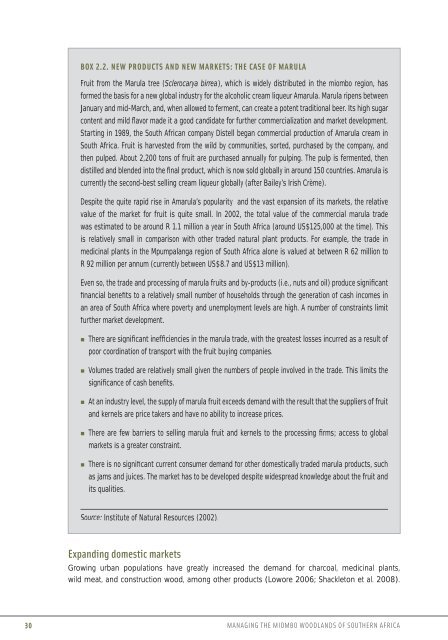Managing the Miombo Woodlands of Southern Africa - PROFOR
Managing the Miombo Woodlands of Southern Africa - PROFOR
Managing the Miombo Woodlands of Southern Africa - PROFOR
You also want an ePaper? Increase the reach of your titles
YUMPU automatically turns print PDFs into web optimized ePapers that Google loves.
BOX 2.2. NEW PRODUCTS AND NEW MARKETS: THE CASE OF MARULA<br />
Fruit from <strong>the</strong> Marula tree (Sclerocarya birrea), which is widely distributed in <strong>the</strong> miombo region, has<br />
formed <strong>the</strong> basis for a new global industry for <strong>the</strong> alcoholic cream liqueur Amarula. Marula ripens between<br />
January and mid-March, and, when allowed to ferment, can create a potent traditional beer. Its high sugar<br />
content and mild flavor made it a good candidate for fur<strong>the</strong>r commercialization and market development.<br />
Starting in 1989, <strong>the</strong> South <strong>Africa</strong>n company Distell began commercial production <strong>of</strong> Amarula cream in<br />
South <strong>Africa</strong>. Fruit is harvested from <strong>the</strong> wild by communities, sorted, purchased by <strong>the</strong> company, and<br />
<strong>the</strong>n pulped. About 2,200 tons <strong>of</strong> fruit are purchased annually for pulping. The pulp is fermented, <strong>the</strong>n<br />
distilled and blended into <strong>the</strong> final product, which is now sold globally in around 150 countries. Amarula is<br />
currently <strong>the</strong> second-best selling cream liqueur globally (after Bailey’s Irish Crème).<br />
Despite <strong>the</strong> quite rapid rise in Amarula’s popularity and <strong>the</strong> vast expansion <strong>of</strong> its markets, <strong>the</strong> relative<br />
value <strong>of</strong> <strong>the</strong> market for fruit is quite small. In 2002, <strong>the</strong> total value <strong>of</strong> <strong>the</strong> commercial marula trade<br />
was estimated to be around R 1.1 million a year in South <strong>Africa</strong> (around US$125,000 at <strong>the</strong> time). This<br />
is relatively small in comparison with o<strong>the</strong>r traded natural plant products. For example, <strong>the</strong> trade in<br />
medicinal plants in <strong>the</strong> Mpumpalanga region <strong>of</strong> South <strong>Africa</strong> alone is valued at between R 62 million to<br />
R 92 million per annum (currently between US$8.7 and US$13 million).<br />
Even so, <strong>the</strong> trade and processing <strong>of</strong> marula fruits and by-products (i.e., nuts and oil) produce signifi cant<br />
financial benefi ts to a relatively small number <strong>of</strong> households through <strong>the</strong> generation <strong>of</strong> cash incomes in<br />
an area <strong>of</strong> South <strong>Africa</strong> where poverty and unemployment levels are high. A number <strong>of</strong> constraints limit<br />
fur<strong>the</strong>r market development.<br />
• There are signifi cant ineffi ciencies in <strong>the</strong> marula trade, with <strong>the</strong> greatest losses incurred as a result <strong>of</strong><br />
poor coordination <strong>of</strong> transport with <strong>the</strong> fruit buying companies.<br />
• Volumes traded are relatively small given <strong>the</strong> numbers <strong>of</strong> people involved in <strong>the</strong> trade. This limits <strong>the</strong><br />
signifi cance <strong>of</strong> cash benefi ts.<br />
• At an industry level, <strong>the</strong> supply <strong>of</strong> marula fruit exceeds demand with <strong>the</strong> result that <strong>the</strong> suppliers <strong>of</strong> fruit<br />
and kernels are price takers and have no ability to increase prices.<br />
• There are few barriers to selling marula fruit and kernels to <strong>the</strong> processing firms; access to global<br />
markets is a greater constraint.<br />
• There is no signifi cant current consumer demand for o<strong>the</strong>r domestically traded marula products, such<br />
as jams and juices. The market has to be developed despite widespread knowledge about <strong>the</strong> fruit and<br />
its qualities.<br />
Source: Institute <strong>of</strong> Natural Resources (2002).<br />
Expanding domestic markets<br />
Growing urban populations have greatly increased <strong>the</strong> demand for charcoal, medicinal plants,<br />
wild meat, and construction wood, among o<strong>the</strong>r products (Lowore 2006; Shackleton et al. 2008).<br />
30 MANAGING THE MIOMBO WOODLANDS OF SOUTHERN AFRICA

















